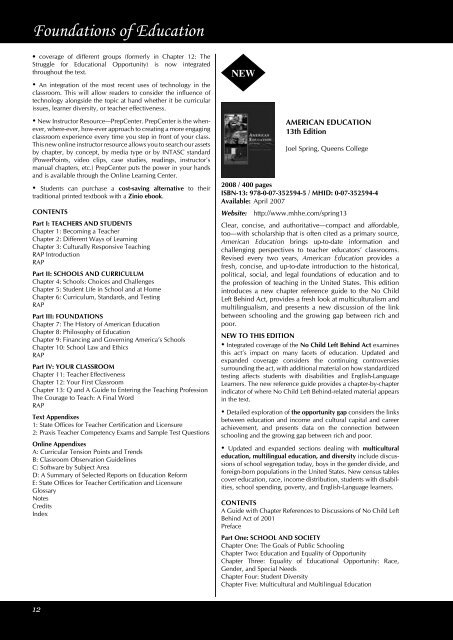table of contents - McGraw-Hill Books
table of contents - McGraw-Hill Books
table of contents - McGraw-Hill Books
Create successful ePaper yourself
Turn your PDF publications into a flip-book with our unique Google optimized e-Paper software.
Foundations <strong>of</strong> Education<br />
• coverage <strong>of</strong> different groups (formerly in Chapter 12: The<br />
Struggle for Educational Opportunity) is now integrated<br />
throughout the text.<br />
• An integration <strong>of</strong> the most recent uses <strong>of</strong> technology in the<br />
classroom. This will allow readers to consider the influence <strong>of</strong><br />
technology alongside the topic at hand whether it be curricular<br />
issues, learner diversity, or teacher effectiveness.<br />
• New Instructor Resource—PrepCenter. PrepCenter is the whenever,<br />
where-ever, how-ever approach to creating a more engaging<br />
classroom experience every time you step in front <strong>of</strong> your class.<br />
This new online instructor resource allows you to search our assets<br />
by chapter, by concept, by media type or by INTASC standard<br />
(PowerPoints, video clips, case studies, readings, instructor's<br />
manual chapters, etc.) PrepCenter puts the power in your hands<br />
and is available through the Online Learning Center.<br />
• Students can purchase a cost-saving alternative to their<br />
traditional printed textbook with a Zinio ebook.<br />
CONTENTS<br />
Part I: TEACHERS AND STUDENTS<br />
Chapter 1: Becoming a Teacher<br />
Chapter 2: Different Ways <strong>of</strong> Learning<br />
Chapter 3: Culturally Responsive Teaching<br />
RAP Introduction<br />
RAP<br />
Part II: SCHOOLS AND CURRICULUM<br />
Chapter 4: Schools: Choices and Challenges<br />
Chapter 5: Student Life in School and at Home<br />
Chapter 6: Curriculum, Standards, and Testing<br />
RAP<br />
Part III: FOUNDATIONS<br />
Chapter 7: The History <strong>of</strong> American Education<br />
Chapter 8: Philosophy <strong>of</strong> Education<br />
Chapter 9: Financing and Governing America’s Schools<br />
Chapter 10: School Law and Ethics<br />
RAP<br />
Part IV: YOUR CLASSROOM<br />
Chapter 11: Teacher Effectiveness<br />
Chapter 12: Your First Classroom<br />
Chapter 13: Q and A Guide to Entering the Teaching Pr<strong>of</strong>ession<br />
The Courage to Teach: A Final Word<br />
RAP<br />
Text Appendixes<br />
1: State Offices for Teacher Certification and Licensure<br />
2: Praxis Teacher Competency Exams and Sample Test Questions<br />
Online Appendixes<br />
A: Curricular Tension Points and Trends<br />
B: Classroom Observation Guidelines<br />
C: S<strong>of</strong>tware by Subject Area<br />
D: A Summary <strong>of</strong> Selected Reports on Education Reform<br />
E: State Offices for Teacher Certification and Licensure<br />
Glossary<br />
Notes<br />
Credits<br />
Index<br />
NEW<br />
AMERICAN EDUCATION<br />
13th Edition<br />
Joel Spring, Queens College<br />
2008 / 400 pages<br />
ISBN-13: 978-0-07-352594-5 / MHID: 0-07-352594-4<br />
Available: April 2007<br />
Website: http://www.mhhe.com/spring13<br />
Clear, concise, and authoritative—compact and affordable,<br />
too—with scholarship that is <strong>of</strong>ten cited as a primary source,<br />
American Education brings up-to-date information and<br />
challenging perspectives to teacher educators’ classrooms.<br />
Revised every two years, American Education provides a<br />
fresh, concise, and up-to-date introduction to the historical,<br />
political, social, and legal foundations <strong>of</strong> education and to<br />
the pr<strong>of</strong>ession <strong>of</strong> teaching in the United States. This edition<br />
introduces a new chapter reference guide to the No Child<br />
Left Behind Act, provides a fresh look at multiculturalism and<br />
multilingualism, and presents a new discussion <strong>of</strong> the link<br />
between schooling and the growing gap between rich and<br />
poor.<br />
NEW TO THIS EDITION<br />
• Integrated coverage <strong>of</strong> the No Child Left Behind Act examines<br />
this act’s impact on many facets <strong>of</strong> education. Updated and<br />
expanded coverage considers the continuing controversies<br />
surrounding the act, with additional material on how standardized<br />
testing affects students with disabilities and English-Language<br />
Learners. The new reference guide provides a chapter-by-chapter<br />
indicator <strong>of</strong> where No Child Left Behind-related material appears<br />
in the text.<br />
• Detailed exploration <strong>of</strong> the opportunity gap considers the links<br />
between education and income and cultural capital and career<br />
achievement, and presents data on the connection between<br />
schooling and the growing gap between rich and poor.<br />
• Updated and expanded sections dealing with multicultural<br />
education, multilingual education, and diversity include discussions<br />
<strong>of</strong> school segregation today, boys in the gender divide, and<br />
foreign-born populations in the United States. New census <strong>table</strong>s<br />
cover education, race, income distribution, students with disabilities,<br />
school spending, poverty, and English-Language learners.<br />
CONTENTS<br />
A Guide with Chapter References to Discussions <strong>of</strong> No Child Left<br />
Behind Act <strong>of</strong> 2001<br />
Preface<br />
Part One: SCHOOL AND SOCIETY<br />
Chapter One: The Goals <strong>of</strong> Public Schooling<br />
Chapter Two: Education and Equality <strong>of</strong> Opportunity<br />
Chapter Three: Equality <strong>of</strong> Educational Opportunity: Race,<br />
Gender, and Special Needs<br />
Chapter Four: Student Diversity<br />
Chapter Five: Multicultural and Multilingual Education<br />
12

















